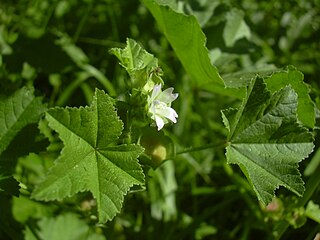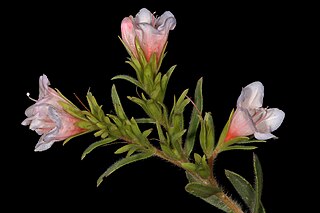
Calendula officinalis, the pot marigold, common marigold, ruddles, Mary's gold or Scotch marigold, is a flowering plant in the daisy family, Asteraceae. It is probably native to southern Europe, but its long history of cultivation makes its precise origin unknown, and it is widely naturalised.

Felicia amelloides, the blue daisy bush or blue felicia, is a hairy, soft, usually perennial, evergreen plant, in the family Asteraceae. It can be found along the southern coast of South Africa. It grows as ground cover and produces many very regular branches. It mostly grows to about 50 cm (1.6 ft) high, rarely to 1 m. The leaves are oppositely arranged along the stems, dark green in colour and elliptic in shape. The flower heads sit individually on up to 18 cm (7 in) long, green to dark reddish stalks. They consist of about twelve heavenly blue ray florets that surround many yellow disc florets, together measuring about 3 cm across. It is also cultivated as an ornamental, and was introduced in Europe in the middle of the 18th century.

Curculigo capitulata is a stout herb that belongs to the genus Curculigo. It is known by the common names palm grass, whale back, and weevil lily, and by various synonyms, including Molineria capitulata. It ranges from the Himalayas and eastern India through Indochina, southern China, Malesia, and New Guinea to Queensland and the Solomon Islands. The plant has yellow flowers and oblong, papery pleated leaves with very short stems. In China and India, the plant has traditional uses as medicine to treat diseases such as hemorrhoids, asthma, and consumptive cough. In Southeast Asia, the plant is also used as food wrapping and the fibres are used to make fishing nets, ropes and false hair. However, in recent years Molineria capitulata is more often used as ornamental plants in gardens. In recent studies, M. capitulata was also found to have potential in treating several chronic diseases due to its high antifungal, antioxidant, cytotoxic, thrombolytic, anti-inflammatory, and analgesic activities.

Malva parviflora is an annual or perennial herb that is native to Northern Africa, Southern Europe, and Western and Central Asia and is widely naturalized elsewhere. Common names include cheeseweed, cheeseweed mallow, Egyptian mallow, least mallow, little mallow, mallow, marshmallow, small-flowered mallow, small-flowered marshmallow, and smallflower mallow. It is used in traditional medicine.

Aloe buettneri is a species of succulent plant in the family Asphodelaceae. It is found in West Africa and is known for its medicinal uses.

Combretum erythrophyllum, commonly known as the river bushwillow, is a medium-sized, spreading tree found in bush near or along river banks in southern Africa. It is planted as a shade and ornamental tree in South Africa and the United States, and is propagated by seed.

Felicia echinata, commonly known as the dune daisy or prickly felicia, is a species of shrub native to South Africa belonging to the daisy family. It grows to 1 m (3.3 ft) high and bears blue-purple flower heads with yellow central discs. In the wild, it flowers April to October.

Felicia dregei is an evergreen, glandular shrub of up to 11⁄2 m (5 ft) high, that is assigned to the family Asteraceae. It has flat, finely felty, grayish green, narrowly elliptic to lance-shaped leaves of up to 4 cm long and 8 mm wide, with an entire margin or here and there with up to ten teeth. The flower heads have about ten violet ray florets, encircling many yellow disc florets. This species grows in the Northern Cape and Western Cape provinces of South Africa.

Felicia brevifolia is an evergreen, richly branched shrub of up to 11⁄2 m (5 ft) high, that is assigned to the family Asteraceae. It has elliptic to wedge-shaped leaves, of between 1⁄2 and 11⁄2 cm long, green to gray-green, many with several teeth. The flower heads have about fifteen blue-violet ray florets, encircling many yellow disc florets. This species grows in southern Namibia and the west of South Africa.

Felicia nordenstamii is a flowering shrub in the family Asteraceae. It is found only in South Africa where it grows on limestone hills close to the sea on the southern coast. Felicia nordenstamii is a many-branched shrub growing up to 30 cm (1 ft) tall. The lower parts of the stems are covered in grayish brown bark and the upper stem has many crowded, upwardly angled, alternate leaves with long hairs on the lower surfaces. Large flower heads form at the tips of the branches, each about 41⁄2 cm across, with about thirty purplish blue ray florets surrounding many yellow disc florets.

Mairia coriacea is a perennial plant assigned to the family Asteraceae. It has broad, tough and leathery, evergreen leaves. These have a narrowed foot and an entire margin or a few shallow, irregular teeth. They grow in a rosette directly from the rootstock. The plant produces flower heads with one whorl of white to mauve ray florets around many yellow disc florets, with one or few on top of a dark reddish, woolly stalk. Flower heads appear after the overhead vegetation burnt down, often destroying the leaves in the process. It can be found in the southern mountains of South Africa's Western Cape province. It is called leather leaves in English.
Felicia wrightii is a low, up to 20 cm (8 in) high, perennial, herbaceous plant with conspicuous basal leaf rosettes, and runners that end in rosettes. It has narrow bracts along the inflorescence stalks on top of which are individual flower heads with an involucre of three whorls of bracts, about sixteen ray florets with about 1 cm long, pale blue straps, that encircle many yellow disc florets. No fertile seeds have been found, so this species may solely reproduce vegetatively. The species is only known from one location in the KwaZulu-Natal Drakensberg, where it grows on damp stream banks.

Mairia robusta is a tufted, white-woolly, perennial, herbaceous plant of up to 30 cm (1 ft) high, that is assigned to the family Asteraceae. It has large, robust, hard and leathery leaves, with a white woolly hairy, nontransparent underside, while the felty hairs on the top are lost with age. Only at a few occasions, flowers have been observed, in June, October and December, always after a fire. The flower heads sit individually at the tip of white-woolly scapes, with 14–16 purplish pink to white ray florets surrounding a yellow disc. M. robusta is an endemic species that is restricted to rocky mountain slopes in the Western Cape province of South Africa.

Mairia hirsuta is a tufted perennial, herbaceous plant of up to 40 cm high, that is assigned to the family Asteraceae. Most of its narrow to broad elliptic or inverted egg-shaped leaves are part of the basal rosette, have margin that is rolled under, with rounded or pointy teeth or with some peg-like extensions, lightly woolly on the upper surface and densely woolly on the underside, but always the green remains visible. Flower heads have been found from July to November, mostly after a fire or when the soil has been disturbed. The species can be found in the southern mountains of the Western Cape province of South Africa.

Aspilia mossambicensis, also known as wild sunflower, is a medicinally useful herbaceous plant of the family Compositae (Asteraceae). It is widespread with an anthropogenic distribution in central and Eastern tropical Africa from Ethiopia, through East Africa, the Congo, Zambia, Zimbabwe, Malawi, Mozambique and South Africa.
Herb or shrub 0.5–1 m or straggling bush to 2.5 m high; branches scabrid. Leaves sessile to shortly petiolate, ovate or elliptic, 2–12´1–3 cm, base cuneate, margins entire or serrate, apex acute or attenuate, scabrid on both surfaces, somewhat 3‑nerved from base; petiole up to 1 cm long. Capitula in loose paniculate corymbs, on stalks to 7 cm long; involucre 4–7 mm high; outer phyllaries yellowish near base, green near apex, hispid‑pubescent; paleae 5–7 mm long, keeled with a dark midrib. Ray florets 8–13, bright yellow, rays 6–20 mm long, glabrous or pubescent above; disk florets yellow, 5–6.5 mm long, often with dark stripes along the tube. Achenes brown, obovoid, 4–5 mm long, pilose; pappus of several connate scales to 0.4 mm long and 1–2 barbellate aristae 1–3 mm long.

Cecropia pachystachya, commonly known as Ambay pumpwood, is a species of tree in the family Urticaceae. It is native to Argentina, Paraguay and Brazil where it grows near the edges of moist forests.
Funtumia africana is a tree within the family Apocynaceae, it is one of two species within the genus Funtumia.

Lobostemon fruticosus, also known as the eightday healthbush or pyjamabush, is a species of medicinal plant endemic to the Cape Provinces of South Africa. It is considered to be ecologically and economically important but is declining due to overexploitation.

Euphorbia neriifolia, also known as Indian spurge tree, hedge Euphorbia, Oleander spurge and fleshy spurge, is a species of spurge native to India, which was originally described by Carl Linnaeus in 1753. Leaves from the plant are used in traditional kajal making in West Bengal, India.
Rachelia is a monotypic genus of flowering plants belonging to the family Asteraceae. It just contains one species, Rachelia glariaJ.M.Ward & Breitw. It is in the tribe Gnaphalieae.


















